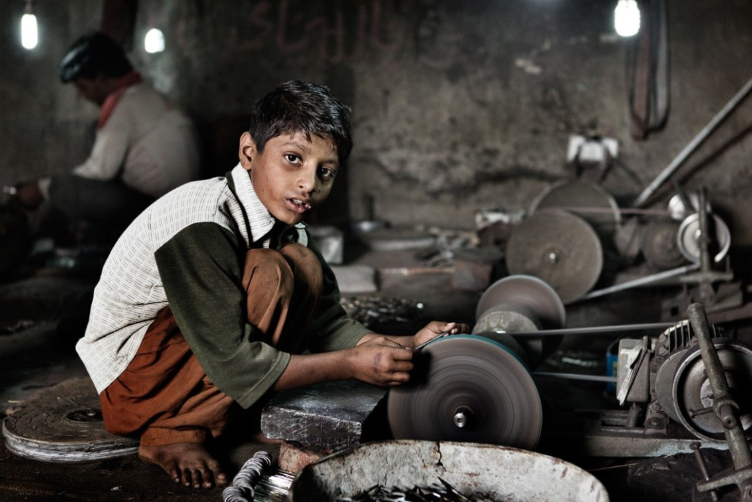Breaking Barriers: Tackling Child Labour and Building a Brighter Future
Social Issues Social Inequalities and exclusionPosted by NewAdmin on 2025-01-28 05:04:27 |
Share: Facebook | Twitter | Whatsapp | Linkedin Visits: 11

According to UNICEF, approximately 160 million children aged 5 to 17 were engaged in child labour globally in 2020—nearly 1 in 10 children worldwide. The COVID-19 pandemic exacerbated this issue, pushing an estimated additional 9 million children into labor. These alarming figures underscore the urgent need to address the root causes, devastating effects, and solutions to this global problem.
Child labour continues to rob millions of children of their education, health, and fundamental rights. For many, a carefree childhood filled with learning and play remains an unattainable dream. Instead, they face harsh realities, working long hours in hazardous conditions, denied the chance to unlock their potential. The practice thrives in low- and middle-income countries, with Sub-Saharan Africa having the highest prevalence. Agriculture is the largest sector employing child labor, followed by services and industry.
The primary driver of child labour is poverty. Struggling families often rely on children to contribute to household income, even at the cost of education and well-being. Limited access to education further compounds the issue, as children outside the classroom are more likely to be exploited for cheap labor. Additionally, unethical businesses exploit children for their low wages and vulnerability, creating unfair competition for adult workers.
The consequences of child labour are devastating. Physically, children face injuries, exposure to harmful substances, and exhaustion. Mentally, the lack of education stunts their cognitive development, while socially, they miss out on the joys of childhood and peer interaction. The cycle of poverty persists as children denied an education grow up without the skills to secure better opportunities.
Addressing child labour requires a comprehensive approach. Education must be prioritized, with accessible, quality schooling provided for all children. Strengthening and enforcing labor laws is crucial to protecting children from exploitation and ensuring violators face accountability. Poverty alleviation through social welfare programs, microfinance initiatives, and job creation can reduce families' dependence on child labor.
Raising awareness about the harmful effects of child labor, promoting fair trade practices, and supporting vulnerable families are also vital. Community engagement and grassroots initiatives help address the root causes, while international cooperation fosters knowledge-sharing and coordinated efforts.
Eradicating child labour is a shared responsibility requiring commitment from governments, businesses, and individuals. Together, we can create a world where every child enjoys a safe, nurturing environment, unlocking their potential for a brighter future.
Search
Categories
- Sports
- Business
- History
- Politics
- International
- Science & Technology
- Social Issues
- Disaster Management
- Current Affairs
- Education
- Startup Business
- Startup News
- Awards
- Community Services
- Fundraising Events
- Volunteer Services
- Health Initiatives
- Innovations and Initiatives
- In News
- dummybanners
- Awards
- Partners
- Products
- Press Releases
- News
- Fast Check
- South
- సినిమా
- Gallery
- Sunday Chronicle
- Hyderabad Chronicle
- లైఫ్ స్టైల్
- National
- క్రైం
- ట్రెండింగ్
- జాబ్స్
- అంతర్జాతీయo
- బిజినెస్
- రాజకీయం
- బిజినెస్
- సంపాదకీయం
- నవ్య
- చిత్ర జ్యోతి
- క్రీడలు
- జాతీయం
- తెలంగాణ
- తాజా వార్తలు
- మన పార్టీ
- మన నాయకత్వం
- మన విజయాలు
- డౌన్లోడ్స్
- మీడియా వనరులు
- కార్యకర్తలు
- North East Skill Center News
- Government Schemes
- Entrepreneurship Support
- Employment Opportunities
- Skill Training Programs
- Departments
- Investments
- Initiatives
- Resources
- Telangana IT Parks
- Events & Jobs
- Press Releases
- News
- Airport News
- Newtons Laws of Motion
- Karbonn in Business
- Investments in Karbonn
- Company quarterly sales
- Markets
- Auto News
- Industry
- Money
- Advertisements
- Stock target
- Company Updates
- Stock Market
- Company Sales
- Staffing and HR
- Constituency Assembly
- General News
- Srikalahasti Temple
- Bojjala Sudhir Reddy
- Technology & Innovation
- Sports
- Business
- Products
- Industries
- Services & Trainings
- Tools & Resources
- Technology Integration
- Drug Seizures & Arrests
- Telangana Narcotics
- Law & Enforcement
- Rehabilitation
- Nationwide Drug Policing
- Nigeria Seizures
- Global Operations
- Drug Awareness
- Drug Enforcement Tech
- NCB Drug Seizures
- Judicial Crackdown
- India's Surveillance Tools
- Cross-Border Links
- Women Safety
- Cyber Crimes
- Drug Abuse
- Traffic & Road Safety
- Community Connect
- Public Safety Alerts
- Citizen Assistance
- Nellore City News
- Politics & Administration
- Events & Festivals
- Agriculture & Rural
- Business & Economy
- Health & Wellness
Recent News
- Putin Playbook: The Art of Declaring Stability
- Capital Gains Subject to Same Tax Rates Even with Section 87A Rebate
- Star Indian Fast Bowler Ruled Out Of Duleep Trophy Due To A Shoulder Injury
- The Ongoing Battle Against Seles Disease
- TPCC chief announces plan for party committee formation, initiates 'vote chori' campaign
- Devendra Fadnavis on Mental Health, Patriotism, and Responsible Freedom
- CM Fadnavis Advocates For 'Balance' In Deciding Stray Dog, Kabootarkhana Issues
- BMC Polls Likely In October, November Or December, EC Will Take Final Call: CM Fadnavis